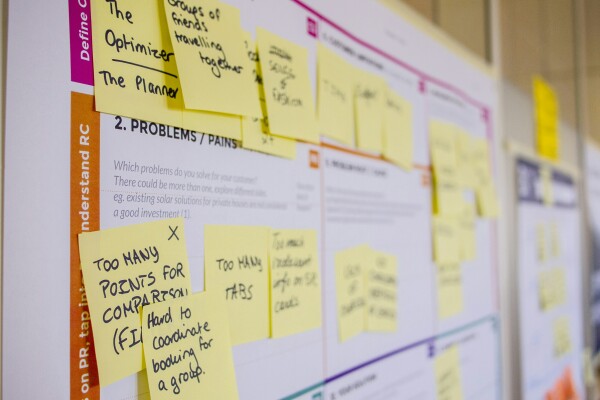Integrating Service Design with Pilot Projects

Moa Mattjus, MBA in Service Design at Novia University of Applied Sciences
Reija Anckar, Ph.D. (Econ.) Head of Master’s Degree Programme in Business, Service Design at Novia University of Applied Sciences
Developing new apps and software programmes is becoming increasingly popular and as a result it has made the process of developing easier. If we look at how many of all apps and software programmes that succeed the numbers are grim. So, why do so many apps fail? One answer to this is the lack of a human perspective while developing the software. Developers and innovators have an idea of what they want and how it could be done –generally they do not have the insights from potential clients.
Prototyping a service is no different from a prototyping a software. The need to gather insights directly from future customers is crucial if you want to succeed. Customers’ needs will make or break your product, as will the users’ pain-points. If the pain-points are identified at the prototyping stage, they can be eliminated and improved upon before the software is being released to the public. One of the most used prototyping methods is to conduct a pilot project to test the product you have - and this is where Service Design comes in!
Service Design is used to design services and products from the end-users’ point of view or as a human-centred approach. Based on the results a minimum viable product is created. Service Design offers a range of methods to develop and improve products and services. However, the process is not linear, it is a controlled chaos to find a good design solution for the product or service.
Using Service Blueprinting will clarify the project at hand and give a visual overview of the pilot project.
To initiate the integration of a standard pilot project and a pilot project with Service Design, we must establish a foundation for the prototype stage. Using Service Blueprinting will clarify the project at hand and provide a visual overview of the pilot project. While blueprinting your project you can add the methods you want to use at different phases. Do you wish to know the first impressions, do you want to know what is challenging for your potential client, or do you want to know what the positive aspects of your product are? All these questions can be answered if we incorporate the right Service Design methods and tools at the right time.
It's important to remember that even with the right methods it can be hard to get the expected results if we do not time them right. If we want to know the pilot group’s first impressions of our software or product, we can for instance use the Think Aloud- method. It is, however, vital to ask if we should use it when presenting the product or when the customer starts using it? The simple answer is that it depends on what we want to know. If we desire to know what prejudices customers’ have about the product without using it, we should use the method when presenting the product, perhaps in written form. If we want to know what users’ thinks when using the app for the first time, then we should use a full-fledged Think Aloud method, recording their spoken thoughts as they test the product for the first time.
When testing the product, we can use other methods to detect the pain-points of our future customers. A Customer Journey Map is perfect to fill out the different stages of the journey for the pilot group. When feedback is gathered, we can map out where most of the friction appears, even though the feedback might not have mentioned it. This advantage positions us ahead of the human factor, which undoubtedly plays a role in a pilot project.

Gathering feedback from a pilot project can be a challenge, as there needs to be some motivations for doing so, but there’s also help at hand. A workshop engaging the pilot group can raise motivation if done correctly. If we show appreciation and let the participants take part in the results, there’s evidence showing it can raise the motivation. This is naturally an important reason to increase the feedback. Whenever there is feedback, there is also analysis. Analysing the feedback and results can be challenging, especially if there’s a lot of feedback. While it largely depends on what is prototyped and how the feedback is gathered, there is a method that can be used in most situations. The PESTLE-analysis. This method doesn’t require any special skills or programmes, and it’s fully customizable to your needs!
What we can conclude from this is that we can use Service Design in a pilot project to enhance the results and to incorporate feedback in the development phase of a product. We need to have a good basis, suitable methods conducted at the right time, engagement, and a good analysis. These pillars together create a good pilot with hints of service design in it to develop your product from a human-centred perspective.
Sources
- Charters, E. (2003). The Use of Think-aloud Methods in Qualitative Research; An Introduction to Think-aloud Methods. Brock Education Journal, 12(2), 68-79. doi:HTTPS://DOI.ORG/10.26522/BROCKED.V12I2.38Levinsen, K., & Ørngreen, R. (2017). Workshops as a Research Methodology. Copenhagen, Denmark, Denmark. Retrieved 11 16, 2022, from https://files.eric.ed.gov/fulltext/EJ1140102.pdf
- Mattjus, M. (2024,). Prototyping Competence Software Using Service Design Methods and Tools. Turku, from https://urn.fi/URN:NBN:fi:amk-2024051411866
- Stickdorn, M., Edgar Hormess, M., Lawrence, A., & Schneider, J. (2018). This Is Service Design Doing : Applying Service Design Thinking in the Real World (1 ed.). O'Reilly Media, Incorporated.
 Short Bio of the Author: Moa Mattjus has a background in tourism- and hospitality management but has later started working within the transport logistics sector as a commercial representative. Moa enjoys gardening and mushroom-picking in her free-time as well as attending cultural events.
Short Bio of the Author: Moa Mattjus has a background in tourism- and hospitality management but has later started working within the transport logistics sector as a commercial representative. Moa enjoys gardening and mushroom-picking in her free-time as well as attending cultural events.
The blogpost has been reviewed by Novia's editorial board and accepted for publication on 6.6.2024.
![]()
MBA Insights
The Novia MBA Insights blog features peer-reviewed posts authored by MBA graduates and their supervisors. Its aim is to disseminate pertinent insights and findings from MBA thesis research.
The subject matter encompasses business, leadership, digitalisation, design thinking, services, project development, and may also touch on societal issues. Posts are selected for their relevance to professionals in the field or the general public.
All blog entries undergo review by a faculty editor and subject matter experts.
We follow CC-BY if nothing else is stated.
Disclaimer: The author(s) are responsible for the facts, any possible omissions, and the accuracy of the content in the blog.The texts have undergone a review, however, the opinions expressed are those of the author and do not necessarily reflect the views of Novia University of Applied Sciences.
Posta din kommentar
Kommentarer
hier 4 dec. 2025 16:36 (40 dagar sen)
Ich spiele sei mehreren Wochen bei hier und bin total
happy! Das Spielangebot ist top, Gewinne kommen sehr schnell, und der Support ist jederzeit hilfsbereit.
Ideal für jeden, die großen Wert auf Qualität setzen!
https://www.kolnoam.com/online-casino-dealers-the-human-element-behind-2/ 25 nov. 2025 16:14 (49 dagar sen)
The online casino industry continues to evolve at a fast pace, offering players a
large variety of reliable operators.
In recent years, many users have become moe focused on regulated environments, choosing
platforms that proovide clear operational standards.
A well-regulated platform typically offers stable financoal handlin and supports balanced gameplay features.
At the same time, players look for modern game mechanics and enjoy smooth navigation.
Overall, the current iGaming sector provides a balanced combination of entertainment and safety, makin it an appealing option for many different typs of players.
https://thelaidbackkids.com/online-free-slots-casino-a-detailed-review-of-12/ 25 nov. 2025 14:53 (49 dagar sen)
Today’s digital casino market continues to grow steadily,
offering players a large variety of rliable
operators.
Over the past few seasons, many users have become more focused on regulated environments, choosing platgforms that provide clear opetational
standards.
A reputable casino typicaly offers stable financial handling and supports responsible gambling tools.
At the same time, regular visitors lok for
modern gamme mechanics and enjoy smooth navigation.
Overall, the currebt iGaming ssctor provides a blend of odern features and structured
oversight, making it an appealing option ffor many
different types of players.
https://rtacont.com.br/2025/08/25/finest-casinos-on-the-internet-united-kingdom-best-gambling-enterprise-websites-reviewed-by-benefits-2025/ 25 nov. 2025 14:23 (49 dagar sen)
Thhe modern iGaming landscape continues to grow steadily, offering players a large variety of reliable operators.
In recent years, many useres have become more focused on security and fairness, chooskng platforms that provide verified game results.
A trusted gaming operator typically offers stable financial handling and supports effective account controls.
At the same time, regular visitors look for updated titles aand enjoy mobile-friendly
interfaces.
Overall, the online casino scene provides a balancrd combination oof
entertainment aand safety, making it an appealing option for many different types off players.
https://gcmajheen.in/2025/10/28/online-casino-best-bonuses-an-expert-examination-18/ 24 nov. 2025 18:27 (50 dagar sen)
The online casino industry continues to evolve at a fast pace,
offering players a diverse mix of gaming sites.
Recently, any users have become mor focused on licening and transparency,
choosing platforms that provide clear operational standards.
A trusted gaming operator typically offers consistent payouts and supports balanced gameplay features.
At thhe same time, users look for updatedd titles and enjoy fast-loading
game libraries.
Overall, the wider casino market provides a mix of regulation and gameplay variety, making it an aplpealing option for many different types of players.
https://civicpost.org/greatest-internet-casino-bonuses-an-informed-2025-sites/ 24 nov. 2025 16:29 (50 dagar sen)
Today’s digital casino market continues to expand rapidly, offedring players a
diverse mix of gaming sites.
Over thee past feww seasons, many users have become more focused on licensing and transparency, choosing platforms that provide
verified game results.
A well-regulated platform typically offers fair return-to-player values and
supports responsible gambling tools.
At the same time, players look for fresh slot releases and enjoy fast-loading gaqme libraries.
Overall, the wider casiono market provides a balanced combination of entertainment and safety,
making it an appealing option for many different types of players.
https://anantalearningcentre.com/online-casino-dealer-jobs-capabilities-training-17/ 24 nov. 2025 15:41 (50 dagar sen)
The modern iGaming landscape continues tto grow steadily, offering
players a wide selection of platforms.
Recently, many users have become more foxused on security and fairness, choosing
platforms that provide clear operational standards.
A well-regulatedplatform typically offers stable financial handling
and supports balanced gameplay features.
At the same time, users look for fresh slot releases and enjoy smooth
navigation.
Overall, the wider casino market provides a balanced combination of entertainment and safety,
making it an appealing option for many different typoes of
players.
https://timberes.field-map.com/2025/10/28/digitale-casino-jackpots-eine-expertenanalyse-zu-12/ 24 nov. 2025 12:53 (50 dagar sen)
Die moderne Casino-Szene in Deutschland entwickelt sich in einem schnellen Tempo und bietet Spielern eine breite Auswahl an Plattformen.
Besonders seit der neuen Regulierung achten viele Spieler stärker auff kontrollierte Rahmenbedingungen.
Ein regulierter Anbieter zeichnet sich durch faire Auszahlungsquoten aus und ermöglicht ein kontrolliertes Spielerlebnis.
Parallel dazu interessieren sich viele Bescher nach modernen Game-Features und abwechslungsreichen Kategorien.
Insgesamt bietet der deutsche Markt eine ausgewogene
Mischung aus Sicherheit und Unterhaltung.
https://wonn-casino.net/ 11 nov. 2025 13:29 (2 månader sen)
Moern casiunos operate as licensed venues where probability and design intersect.
Lately, brick-and-mortar and digital casinos have
adopted independent testing to verify fairness.
Certified RNGs govern outcomes, while public return-to-player figures hlp pllayers gauge expectations.
Players can choose slots, tables, and live games with documented procedures and
responsible tools like cool-off periods. Good bankroll habits and measured play reduce volatility.
At its core, the casino setting combines risk with regulation,
where knowledge of odds count more than guesswork.
https://verdecasino-cz.cz/ 11 nov. 2025 13:25 (2 månader sen)
Modern casinos work as contdolled gaming envirknments wheree mathematics and ddesign blend.
Ovver the past decade, physical venes and iGaming sites have adopted transparent licensing to ensure integrity.
Independently tested RNGs govern outcomes, while published payout data clarify long-term odds.
Participants can select slots, tables, and live games with documented procedures and responsible tools like cool-off periods.
Goood bankroll habits and steady pacing reduce volatility.
Ultimately, this industry combines risk with regulation,
where knowledge of odds matter more than guesswork.
1 2 3 4 5 6 nästa »
Inga har kommenterat på denna sida ännu